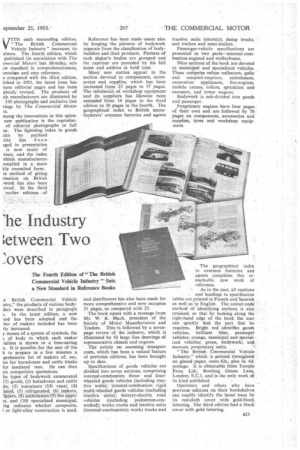he Industry 1etween Two avers
Page 57

If you've noticed an error in this article please click here to report it so we can fix it.
The Fourth Edftion of "The. British Commercial Vehicle Industry " Sets a New Standard in Reference Books VITH each succeeding edition, "The British Commercial Vehicle Industry" increases its ulness. The fourth edition, which published (in association with The lmercial Motor) last Monday, sets w standard in Comprehensiveness, entation and easy reference.
s compared with the third edition, lished in 1951, the latest issue has fore editorial pages and has been pletely revised. The products of sh manufacturers are illustrated by . 330 photographs and exclusive line rings. by The Commercial Motor ts.
mong the innovations in this spielsnew publication is the reproducof editorial photographs in full ur. The lightning index to goods cies by payload
city has be e n. sged in presentation is now easier of -ence, and the index chicle manufacturers ompiled in a more kly consulted form. se method of giving rtnation on British rwork has also been .oved. In the . third earlier editions... of
.e British Commercial Vehicle istry," the products of various bodyders were described in paragraph 1. In -the latest edition, a new sod has been adopted and the her of makers included has been tly increased.
y means of a system of symbols, the 3 of body in which each maker ializes is shown in a time-saving a. It is possible for the user of the k to prepare in a few minutes a .prehensive list of makers of, say, ies for horseboxes and cattle trucks for insulated pans. He can then in competitive quotations.
he types of bodywork enumerated (1) goods, (2) horseboxes and cattle ks, (3) containers (lift vans), (4) lated, (5) refrigerated, (6) tankers,
lisPers, ainhidarices-(9) fire applis, and (10) specialized municipal. ing indicates whether composite, or light-alloy construction is used.
Reference has been made easier also by keeping the pictures of bodywork separate from the classification of bodybuilders and their products. Pictures of each maker's bodies are grouped and the captions are preceded by his full name and address in bold type.
Many new entries appear in the section devoted to components, accessories and, supplies, which has been increased from 23 pages to 37 pages. The tabulation of workshop equipment and its suppliers has likewise been extended from 14 pages in the third edition to 30 pages in the fourth. The geographical index to British manufacturers' overseas factories and agents and distributors has also been made far more comprehensive and now occupies 31 pages, as compared with 25.
The book opens with a message from Mr. W. R. Black, president of the Society of Motor Manufacturers and Traders. Thisis followed by a sevenpage review of the. industry, which is illustrated by 10 large line drawings of representative chassis and engines.
The article on assessing transport costs, which has been a valued feature of previous editions, has been brought up to date.
Specifications of goods vehicles are divided into seven sections, comprising internal-combustion threeand fourwheeled goods vehicles (including tractive units); internal-combustion rigid multi-wheeled goods vehicles (including tractive' Units); battery-electric road vehicles (including pedestrian-controlled); works trucks and tractive units (internal-combustion); works trucks and tractive units (electric); dump trucks, and trailers and semi-trailers.
Passenger-vehicle specifications arc presented in two parts—internal-cornbustion-engined and trolleybuses.
Nine sections of the book are devoted to municipal and specialized vehicles. These comprise refuse collectors, gully and cesspool-emptiers, ambulances, excavation appliances, fire-engines, mobile cranes, rollers, sprinklers and sweepers, and tower wagons.
Bodywork is sub-divided into goods and passenger.
Proprietary engines have four pages of their own and are followed by 70 pages on components, accessories and supplies, tyres and workshop equipment.
The geographical index to overseas factories and agents completes this remarkable new work of reference.
As in the past, all captions and headings to specification tables are printed in French and Spanish as well as in English. The colour-code method of identifying sections is also retained, so that by looking along the right-hand edge of the book the user can quickly find the part that he requires. Bright red. identifies goods vehicles, brilliant blue, passenger vehicles; orange, municipal. and specialized vehicles; green, bodywork; and maroon, proprietary units.
"The British Commercial Vehicle Industry," which is printed throughout on glazed paper, costs 42s., plus 2s. 6d. postage. It is obtainable from Temple Press Ltd., Bowling Green Lane, London, E.C1, and is the only work of its kind published.
Operators and others who have previous editions on their bookshelves can readily identify the latest issue by its red-cloth cover, with gold-block lettering. The third edition had a black cover with gold lettering.




























































































